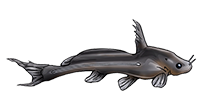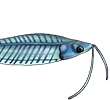Article © Shane Linder, uploaded January 01, 2002.
In less than an hour, we had all the fish that we could carry from Santo Domingo. We all climbed back in Norbert's truck to bounce another 30 minutes down dirt roads across the Llanos. Actually, we did not bounce too much since Norbert has a new 2000 Chevy Grand Blazer with air conditioning and a CD player (now that is collecting in style!).
Santo Domingo and Tinaco are located in the Venezuelan great plains known as the Llanos. This area is not what the typical hobbyist pictures when they think about where their fish come from. The Llanos are flat, dusty, and very hot in the dry season. To envision the Llanos, think of central California in the summer. This time of year, a few rivers wind through these plains and few small swamps remain where there were large lakes in the wet season. Despite the inhospitable environment, the Llanos are home to jaguars, the anaconda, and a dozen spp. of piranhas which are all creatures that North Americans and Europeans usually associate with tropical jungles.
As the crow flys, there is less than a ten miles between the Rio Santo Domingo and the Rio Tinaco, so I was very amazed at the difference in the fish species. This is really a comparison of habitats since both rivers flow into the Rio Portuguesa. Santo Domingo is a true cano that fluctuates between a river and small pools depending on the time of year. The Rio Tinaco, even in the dry season, still has some current and moves along. The Tinaco was very low the day we collected. Norbert said that this was the lowest he had ever seen the river. In places, it was actually possible to jump across the river. The river had a substrate of sand and gravel with several large driftwood snags. The temperature was about 80F, pH 7.5, and the water surprisingly hard at close to 3,000 mu. The reason for the higher pH and hardness is that the Tinaco origintaes in the mountains while the Santo Domingo just takes drainage from the surrounding plains. The other major difference is that since the Tinaco never drys, it is full of piranhas, electric eels, and freshwater rays. Nearly all of the fish collected exhibited damaged fins from piranha attacks
Piranhas (despite the legends) are not really a danger to the collector. Electric eels and stingrays, however, are another story. Electric eels like to hide under cutbanks. These are normally great collecting locations, but because there are so many electric eels here, we avoided the eroded inside banks. Stingrays prefer shallow water with a sandy bottom. When crossing these areas, always take a long walking stick and probe the sand ahead of you as you walk. A fishing guide that I know in Camatagua was once stung by a ray and he was down for three months before he could return to work. He is also missing the tip of his index finger because he was not paying attention once while removing the hook from a piranha's mouth. Now that is a mistake you only make once!
An afternoon's collecting yeilded:
- Panaque nigrolineatus (3 all under two inches)
- Lamontichthys (12 specimens)
- Loricaria (a beautiful mottled white and gray sp.) rare
- 1 Cochliodon
- Hypostomus plecostomus
- Squaliforma watwata
- Hypostomus aff. L-153 (this will need to grow before I can ID them)
- Otocinclus sp.
- Hypoptopoma sp.
- Panaque similar LDA-22
- Glyptopterichthys sp. similar L-154
- Lasiancistrus sp (similar L-92)
- Tatia sp.
- Trichomycterids (2 spp)
- Heptapterus sp. (?)
Lamontichthys are only found amongst driftwood near riffles. Most loricariids were, as you would expect, caught amongst driftwood piles. Hypoptopoma are best located where erosion has caused a living tree to fall in the water. In these areas, they are very thick and as many as 20 can be caught in one sweep of the net. At Santo Domingo we caught only small (under 1.5 inch) Hypoptopoma while at Tinaco they were all in the 3 inch range. The largest LDA-22s were 3 inches.
The Heptapterus sp. is very strange. At first I thought they were just another trichomycterid. Only by looking very closely did I note the long barbels. The species is entirely black and I kept a few to see how they do in captivity.
Norbert had promised great pleco collecting, and at the end of the day, I had no complaints.
The biotope for the Tinaco is just what you would picture for a typical pleco tank. Use the largest tank possible and fill it up with twisting driftwood branches. I do not mean to use a few pieces of driftwood, I mean stuff the tank with tangles of wood. The end product should fill the entire tank with a maze of branches. In addition to good filtration, add a couple of strong powerheads to keep the water oxygenated and moving. The only really difficult thing to reproduce would be the holes in the bank that many loricariids use to spawn in during the wet season. Substitute these with clay or plastic tubes hidden at the back of the tank.
There is further information on this species on the Cat-eLog page.
Back to Shane's World index.




